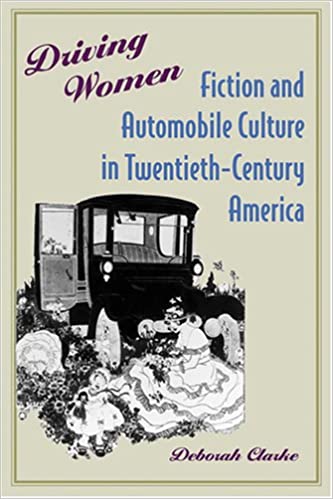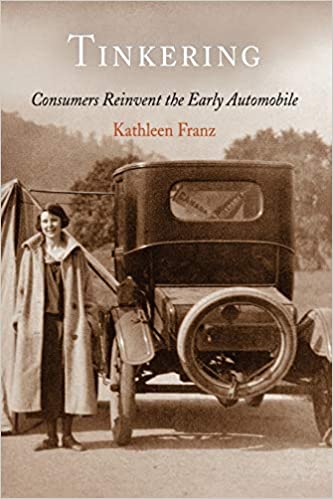While in graduate school during the 2000s, I devised an independent study focused on my growing interest in the relationship between women and cars. What follows is one of the response papers in which I examine how feminist historians initially responded to the question “What is Woman’s Place in American Car Culture?”, incorporating some of the more recent literature in women’s automotive scholarship.
In 1980, Charles L. Sanford introduced a question that few in the auto industry, academia or popular culture had ever bothered to ask. And that is, “what is woman’s place in American car culture?” Sanford’s inquiry attempted to initiate an investigation into women’s limited and often invisible role in American car culture and automotive social history. Sanford made visible a notable lack in scholarship devoted to the relationship between women and cars. In the two decades that followed, feminist historians and literary scholars initiated an effort to address Sanford’s question.

Virginia Scharff, in her seminal work Taking the Wheel, and Margaret Walsh, through her work with The Henry Ford and the University of Michigan-Dearborn, as well as a number of articles focusing on distinct periods in women’s automotive experience, provide historical analyses of the automobile industry and women’s determined struggle to construct a place within it. Deborah Clarke addresses Sanford’s question through an examination of women’s literature in which the automobile assumes an important role. Clarke suggests that women have always considered themselves participants in car culture, but validation and recognition of such a place often eludes them. While Scharff, Walsh and Clarke respond to Sanford’s inquiry through the lens of varying disciplines, each uses the category of gender, and the social construction of masculinity and femininity in relation to the automobile, as the basis of analysis. Each strongly argues that the masculinity built into and associated with automobility has not only influenced auto industry decisions and policy, but has also established impenetrable barriers to woman’s relationship with the car, and woman’s place in car culture.
The automobile was imbued with masculinity from its conception. As the Industrial Revolution assured that man and machine would become irrevocably linked, the automotive industry, the product of that industry and the driver of the product were henceforth labeled masculine. This stalwart and stubborn association of automobile technology with masculinity often postponed or prevented those innovations perceived as feminine. Necessary improvements in comfort, style, luxury, economy and safety were often considered a concession to female tastes and received low priority in automobile production. Scharff provides a number of instances in which notions about gender not only blinded automakers to potential markets for their products, but set industry progress and production back unnecessarily as well. Scharff writes, “what some observers of the 1920s saw as […] a drive toward the decorative in automotive design, others interpreted as the emasculation of both industry men and the cars they made” (Wheel 113). The industry rarely asked women what they desired in a car, as acknowledgement of such responses might infer auto industry feminization. While industry leaders recognized the potential of the female customer, they grappled with how to appeal to the feminine market while keeping the masculinity of the automobile, and those who produced them, intact.
The auto industry responded by calling upon “innate” biological differences to suggest that men and women would “naturally” have different needs and expectations for the automobile. Automakers promoted women’s use of the automobile for its practical applications; thus the car, in women’s possession, became a domestic technology for the performance of prescribed gendered tasks. Unlike male drivers, women were not encouraged to identify with the car; the car was to occupy the same place in women’s lives as the vacuum cleaner and sewing machine. Scharff tells us, “as the automobile industry revolutionized the nation’s geographical, economic and cultural landscape […] it also played no small part in reinscribing assumptions about masculinity and femininity” (Wheel 112). The association of the automobile with masculinity served not only to reinforce the dominance of men’s privileged position in the car, the auto industry and society as a whole, but also affirmed woman’s proper place in public, on the road and in the home. As Scharff asserts, “auto industry decision makers, virtually all male, wanted to believe in the continued dominance and desirability of men’s privileged position in society and in economic matters” (Wheel 116). Thus woman’s “place” in car culture became where those in power wanted her to be: behind the wheel, but only in the fulfillment of her culturally prescribed domestic role.

In Driving Women, Deborah Clarke elaborates on the conflation of the car with the man who drives it. She writes, “more than any other machine, [the car] became anthropomorphized in American culture, generally functioning as both extension of the self and treasured companion” (47). As the car is associated with masculinity, car culture is a male culture. Women’s place in is most often defined in relationship to men and men’s cars. In such contexts, women are often accessories or sexual objects to be controlled or conquered. Women are utilized to enhance or confirm masculinity; their “place” is clearly subservient to that of the car and the man who drives it. As Clarke tells us, “popular myth associates cars with masculinity, and automobile advertising continues to link the car to the female body, promising men control over speed and women” (1). Yet what Sanford suggests and which Clarke confirms is that many women have a relationship with cars that is often comparable in kind and intensity to that expressed by men. Women ascribe meanings to cars; they call on the car’s ability to erase boundaries of home and the domestic sphere, and to provide a sense of independence, freedom and mobility. As Clarke writes, “the car allows women a position from which to construct individual identity, exercise individual agency, and chart a course as acknowledged individuals in American culture” (4). Yet while each of the contributors acknowledges the continuous presence of women in car culture, none offers a suggestion to make women’s presence better known. While Scharff, Walsh and Clarke are unanimous in ascribing importance to women’s participation, “given that cars often determine our place in American society,” not one of them offers a remedy for women’s continued invisibility in the auto industry and in American car culture (Clarke 8).

In “A Woman’s Place in American Car Culture,” Charles Sanford writes, “what is needed is both an intimate feminine viewpoint from several perspectives about women’s experience with cars”(140). Scharff, Walsh and Clarke have provided such insight, but it is not enough. While Clarke calls upon the car as a “vehicle” to examine women’s place, such an analysis does nothing to improve women’s standing in the automotive industry or in car culture. In order to change the mentality of the American car industry, the importance of women to American car culture must become common knowledge. Society has historically underestimated the importance of cars to women. Automakers continue to shape and construct woman’s place in car culture in its own image, persisting in the narrow, like-minded, inbred thinking that has plagued the industry for generations. Women have a place in car culture independent of that prescribed for them. It is up to them to let automakers, and the world, know exactly what it is.

Since this essay was written in 2008, new scholars have approached this topic from various points of view. In Eat My Dust, Georgine Clarsen provides a counterpart to Scharff as she shifts the focus from automakers to female motorists and their efforts to become recognized as competent drivers within early twentieth-century America. Social historian Kathleen Franz dispels the notion of the woman driver as mechanically inept by drawing on accounts of early female motorists involved in the practice of “tinkering” in her book of the same name. Katherine Parkin investigates the gendered ways Americans have purchased, driven, and repaired automobiles since the early twentieth century in Women at the Wheel: A Century of Buying, Driving, and Fixing Cars. And in my own work, I have investigated women’s participation in various car cultures – chick cars, muscle cars, motorsports, and pickup trucks – as well as examined representations of the woman driver in locations such as popular music and film. These additional twenty-first-century projects have brought more attention to the woman driver; certainly the ascension of Mary Barra to the helm of General Motors has challenged the common assumption that women have little interest or knowledge of cars. But until women are universally recognized as being men’s equal automotive culture, there remains work to be done.
Clarke, Deborah. Driving Women: Fiction and Automobile Culture in Twentieth-Century America. Baltimore: The Johns Hopkins University Press, 2007.
Clarsen, Georgine. Eat My Dust: Early Women Motorists. Baltimore: The Johns Hopkins Press, 2008.
Franz, Kathleen. Tinkering: Consumers Reinvent the Early Automobile. Philadelphia: The University of Pennsylvania Press, 2005.
Parkin, Katherine. Woman at the Wheel: A Century of Buying, Driving, and Fixing Cars. Philadelphia: University of Pennsylvania Press, 2017.
Sanford, Charles. “‘Woman’s Place’ in American Car Culture.” The Automobile and American Culture. D.L. Lewis & L. Goldstein, eds. Ann Arbor: The University of Michigan Press, 1983. 137-152.
Scharff, Virginia. Taking the Wheel: Women and the Coming of the Motor Age. Albuquerque: University of New Mexico Press, 1991.
Walsh, Margaret. “At Home at the Wheel? The Woman and her Automobile in the 1950s.” The Third Eccles Centre for American Studies Plenary Lecture: Proceedings of the British Association of American Studies Annual Conference, 2006. The British Library (2007): 1-21.
— “Gender and Automobility: Selling Cars to American Women after the Second World War.” Charm (2009): 295-310.
— “Gender and the Automobile in the History of the United States.” Automobile in American Life and Society. University of Michigan-Dearborn. 2004-2010.